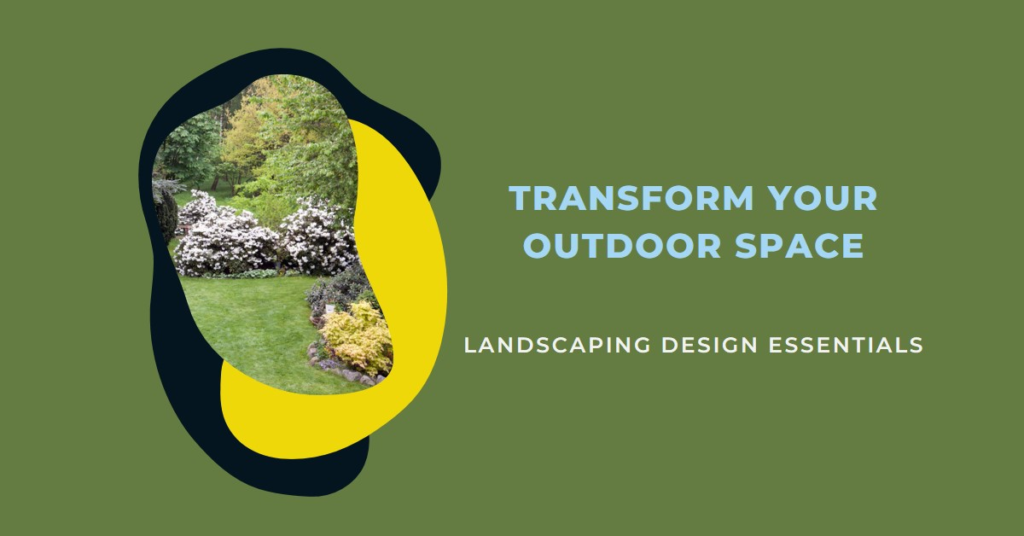
Table of Contents
Introduction to Landscaping Design :
In the realm of outdoor aesthetics, landscaping design stands as the cornerstone of transforming mere spaces into captivating sanctuaries. Whether it’s the verdant embrace of a lush garden or the harmonious interplay of hardscapes and softscapes, every element plays a pivotal role in crafting a breathtaking outdoor haven. To embark on this journey of metamorphosis, one must grasp the essentials of landscaping design, where creativity meets functionality, and nature intertwines with human ingenuity.
Section 1: Understanding the Canvas: Assessing Your Outdoor Space
Before diving into the realm of landscaping design, one must embark on a journey of understanding their outdoor canvas. Conducting a comprehensive assessment of the available space lays the groundwork for the design process. Factors such as terrain elevation, soil composition, sunlight exposure, and existing vegetation profoundly influence the design decisions. By keenly observing these elements, designers can unlock the full potential of the space, envisioning possibilities that harmonize with nature’s nuances.
Section 2: Defining the Vision: Establishing Design Objectives
With a clear understanding of the canvas, the next step entails defining the vision for the outdoor space. Establishing design objectives serves as a guiding light, steering the landscaping process towards a coherent and compelling end result. Whether the goal is to create a tranquil retreat, an entertainment hub, or a sustainable ecosystem, articulating these aspirations sets the tone for the entire design journey. By aligning with the client’s preferences and the site’s inherent characteristics, designers can sculpt landscapes that resonate with both aesthetic beauty and functional utility.
Section 3: Sketching the Blueprint: Designing Layouts and Structures
Once the vision is crystalized, it’s time to breathe life into the design through meticulous planning and layout sketching. Designing the blueprint involves delineating pathways, defining garden beds, and integrating hardscape elements such as patios, decks, and pergolas. Transitioning from conceptualization to concrete plans empowers designers to visualize spatial relationships and ensure optimal utilization of every inch of the outdoor expanse. Through active engagement with the design process, clients can provide invaluable feedback, fostering a collaborative journey towards realizing their outdoor dreams.
Section 4: Embracing Biodiversity: Selecting Plants and Greenery
At the heart of every mesmerizing landscape lies a vibrant tapestry of plants and greenery, each species contributing its unique charm to the ensemble. Selecting the right plants entails more than just aesthetic considerations; it involves a nuanced understanding of climatic conditions, soil compatibility, and maintenance requirements. By embracing biodiversity and incorporating native flora, designers not only enhance ecological resilience but also foster habitats for local wildlife. From colorful blooms to verdant foliage, every plant selection adds layers of texture and character to the outdoor tableau, transforming it into a living, breathing masterpiece.
Section 5: Harnessing the Power of Elements: Water Features and Lighting
In the realm of landscaping design, water features and lighting serve as transformative elements, imbuing outdoor spaces with a sense of serenity and enchantment. Whether it’s the soothing trickle of a fountain or the gentle shimmer of moonlight, these features elevate ambiance and extend the usability of outdoor areas well into the evening hours. Incorporating water elements such as ponds, streams, or waterfalls introduces dynamic movement and auditory delight, while strategic lighting accents focal points and creates captivating interplays of light and shadow. Through thoughtful placement and design, these elements seamlessly integrate into the landscape, enhancing its allure and allure.


Section 6: Balancing Form and Function: Furniture and Accessories
Beyond mere aesthetics, landscaping design encompasses the thoughtful integration of furniture and accessories that marry form with function. From cozy seating arrangements to functional outdoor kitchens, these elements invite inhabitants to immerse themselves fully in the outdoor experience. Choosing durable materials that withstand the rigors of weather ensures longevity and minimal maintenance, allowing outdoor spaces to remain inviting retreats year-round. By striking a delicate balance between comfort and practicality, designers can curate outdoor environments that beckon both relaxation and social interaction, fostering cherished moments amidst nature’s embrace.
Section 7: Sustainable Landscaping Practices: Nurturing the Environment
In an era of heightened environmental consciousness, sustainable landscaping practices emerge as imperative considerations in design endeavors. By embracing techniques such as xeriscaping, rainwater harvesting, and native plant cultivation, designers minimize water consumption, reduce chemical inputs, and promote ecological resilience. Moreover, integrating permeable paving materials and green roofs mitigates stormwater runoff, alleviating strain on municipal infrastructure and preserving water quality. Through conscious stewardship of the land, landscaping design transcends mere aesthetics, becoming a catalyst for positive environmental change and ecological restoration.
Section 8: Cultivating Seasonal Flourish: Maintenance and Care
The journey of landscaping design doesn’t conclude with the completion of installation; rather, it evolves into a commitment to nurturing and maintaining the outdoor oasis throughout the seasons. Cultivating seasonal flourish involves regular pruning, fertilization, and pest management to ensure the vitality and vibrancy of plants and greenery. Additionally, adjusting irrigation schedules and mulching beds optimize water retention and soil health, fostering thriving ecosystems within the landscape. By partnering with experienced landscapers or undertaking DIY maintenance efforts, homeowners can preserve the beauty and functionality of their outdoor spaces for years to come, savoring the ever-changing tapestry of nature’s bounty.
Section 9: Evolving Landscapes: Adaptation and Innovation
As landscapes mature and lifestyles evolve, the journey of landscaping design unfolds as a dynamic and iterative process, ripe with opportunities for adaptation and innovation. Whether it’s integrating smart technology for automated irrigation systems or experimenting with new plant varieties for enhanced biodiversity, embracing change ensures that outdoor spaces remain relevant and responsive to the needs of inhabitants. By staying attuned to emerging trends and harnessing creativity, designers can continually reimagine outdoor environments, breathing new life into familiar landscapes and perpetuating the enchantment of the great outdoors.
Conclusion:
In conclusion, landscaping design transcends the realm of mere aesthetics, evolving into a holistic endeavor that harmonizes human habitation with the natural world. By embracing the essentials of assessment, vision, planning, and stewardship, designers wield the transformative power to sculpt outdoor oases that captivate the senses and nourish the soul. Through a symphony of elements – from lush greenery to cascading water features – landscapes become immersive sanctuaries, inviting inhabitants to embark on a journey of exploration and renewal amidst the ever-changing tapestry of nature’s beauty.


